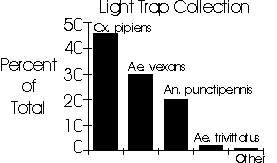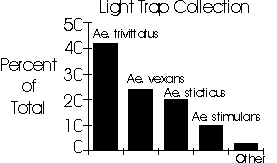Reproduced from the Proceedings of the 77th Annual Meeting of the NJMCA. Please use the following citation when referring to this article:
Duryea, R. D. 1990. Aedes trivittatus in New Jersey. Proc. N. J. Mosquito Control Assoc. pp. 73-78.
AEDES TRIVITTATUS IN NEW JERSEY
ROBERT D. DURYEA
Warren County Mosquito Extermination Commission, P.O. Box 388, Furnace Street, Oxford, NJ 07863
ABSTRACT: Aedes trivittatus is a floodwater mosquito with varying distribution throughout New Jersey. Coastal areas report no nuisance levels due to Ae. trivittatus while the northwest corner of the state routinely records severe widespread nuisance levels. Adult and larval identification, habitat and surveillance will be discussed in this paper.
INTRODUCTION: Aedes trivittatus is a floodwater nuisance mosquito found east of the Rocky Mountains in the United States up to the Canadian border (Darsie & Ward 1981). Ae. trivittatus is found throughout New Jersey with varying degrees of density. Coastal areas from Cape May up through Hudson County record very few Ae. trivittatus in their surveillance programs. Throughout the southwestern and central parts of the state, moderate numbers of Ae. trivittatus cause localized nuisance problems. In the northwest section of the state, Ae. trivittatus are a severe nuisance during most of the summer months. In Warren County, New Jersey, Ae. trivittatus has emerged over the past several years as the primary nuisance mosquito species generating more complaints than any other mosquito species.
MORPHOLOGY: Adult Aedes trivittatus are characterized by Carpenter and LaCasse (1955) as being medium in size, having unbanded legs, dark unbanded surface on the dorsum of the abdomen and clear unspotted wings. The most prominent feature is the presence of two stripes of white scales separated by a narrow band of dark scales running down the top of the mesonotum (Stojanovich, 1961).
Ae. trivittatus larvae are also medium sized. A fourth instar Ae. trivittatus larva is slightly smaller than a fourth instar Aedes vexans. According to Carpenter and LaCasse (1955) the larvae have antennae half as long as the head, upper frontal 5 and lower frontal 6 head hairs are single. The air tube is short and stumpy. Siverly (1972) states that the 17-26 comb scales on the eight segment are arranged in a patch.
BIOLOGY: Ae. trivittatus larvae can be found in a variety of freshwater habitats. Flooded woodlands, marshes, open pools and woodland pools can hold Ae. trivittatus larvae. There is no clear preference for one particular habitat type but many New Jersey counties report collecting larvae in wooded stream corridor areas.
The larvae first appear throughout most of New Jersey with the advent of the warm late spring floodwaters. Hatching has been found to be triggered by a direct reduction in the dissolved oxygen content of the floodwater (Gjullin, 1941).
Ae. trivittatus develop very fast in the hot summer sun. When daytime temperatures of 80's and 90's are accompanied by warm nights, the larvae can proceed from hatching to adulthood in as little as 5 days.
Adult Ae. trivittatus tend to stay relatively close to their breeding areas (Carpenter & LaCasse, 1955). This is substantiated by the observations of the Warren County Mosquito Commission that rarely do Ae. trivittatus cause nuisance problems at distances of one-half mile or greater from the breeding area.
Adult Ae. trivittatus can cause severe nuisance problems wherever they occur in close proximity to human populations. Three reasons account for their nuisance potential:
- Ae. trivittatus are persistent aggressive biters often attacking the victim in a swarm-like manner.
- To most people who encounter Ae. trivittatus, the bite is much more painful and irritating than other mosquitoes encountered.
- They do not hesitate to bite in bright sun or open areas when their haunts are invaded.
SURVEILLANCE: Light traps are ineffective at assessing true adult populations of Ae. trivittatus. The Warren County Mosquito Commission along with other counties (Downing, 1974 and Lombardi, 1976) have observed through comparative surveillance that Ae. trivittatus populations can be extremely high while light trap catches remain low or not present.
Figures 1 and 2 show the disparity that is encountered when light trap and landing rates for Ae. trivittatus are compared. In Warren County, landing rates are also taken at each light trap station. Every station reveals the inadequacies of the light trap as an Ae. trivittatus surveillance tool. While Ae. trivittatus was the dominant landing rate mosquito sometimes forming 70% to 80% of the catch, they account for a very low percentage of the light trap collection.

FIG 1. Light trap catch for the month of July, 1989 at Bear Creek, Warren County, New Jersey.

FIG 2. Landing Rate catch for the month of July, 1989 at Bear Creek, Warren County, New Jersey.
Landing rates are an extremely effective tool to ascertain true nuisance populations of Ae. trivittatus as well as other mosquitoes present. If the landing rate is conducted during midday hours, brushy areas should be invaded to stir the resting mosquitoes.
CDC carbon dioxide baited traps will also reveal the presence of nuisance populations of Ae. trivittatus. The trap should be placed within the vegetation wherever suspect populations might occur. Although not an efficient long term sampling device, short term population estimates can be accurately monitored using this trap.
Resting boxes will attract adult Ae. trivittatus if they are placed in thick herbaceous cover or around rotting timber. Again the surveillance must be in proximity to the adult population and breeding area to have the adults visit the resting box.
Ae. trivittatus larvae can be elusive to larval surveillance efforts. The larvae are sensitive to the presence of humans and dive to the substrate upon approach. If care is not taken to scrape the substrate when dipping, they might not be present in the sample. They also tend to be slightly smaller than their common habitat associate Aedes vexans. Therefore, sampling as many larvae as possible for lab ID is recommended.
CONCLUSIONS: Although Ae. trivittatus is a mosquito frequented throughout the state, some careful surveillance methods when employed properly will reveal its true stature in the mosquito community. Ae. trivittatus has not been implicated as a vector in New Jersey but in Pennsylvania they have been linked to various subtypes of Snowshoe Hare Virus (Wills, 1975). The heightened nuisance potential that they hold along with the surveillance problems they pose make Ae. trivittatus an interesting foe.
REFERENCES CITED
- Carpenter, S.J. and W.J. LaCasse. 1955. Mosquitoes of North America, North of Mexico. University of California Press, Berkeley, CA. pp. 249-251, PL. 92.
- Darsie, R.F. and R.A. Ward. 1981. Identification and Geographical Distribution of the Mosquitoes of North America, North of Mexico. American Mosquito Control Association.
- Downing, J.D. and L.E. Hagmann. 1974. New Jersey Mosquito Surveillance Report. Proc. N.J. Mosquito Extermination Association 61:168-179.
- Gjullin, C.M., M. Hegarty and W.B. Bollen. 1941. The necessity of a low oxygen concentration for the hatching of Aedes mosquito eggs. Journal Cell & Comp. Physiol. 17:193-202.
- Lombardi, R.W. and C.F. Imber. 1976. The application of surveillance data to operational mosquito control. Proc. N.J. Mosquito Extermination Association 63:134-136.
- Siverly, R.E. 1972. Mosquitoes of Indiana. Indiana State Board of Health. Indianapolis, IN. pp. 72-74.
- Stojanovich, C.J. 1961. Illustrated Key to Common Mosquitoes of Northeastern North America. Cullom & Gherter Pub. Co. USA.
- Wills, W., V. Pidcoe, G.E. Jones, D.F. Carrol, J.E. Satz and C.H. Calisher. 1975. New geographical and mosquito records for Snowshoe Hare virus. Proc. N.J. Mosquito Extermination Association 62:75-80.
DISCUSSION FOLLOWING THE PRESENTATION
QUESTION: Bob, have you noticed any kind of a difference or a preference for Ae. trivittatus breeding in open sunlight versus a shaded woodland pool?
DURYEA: We sampled them everywhere and there seems to be a preference for woodland pools and stream and river corridor areas. Of course you do find more woodland pools in stream and river corridors so that could be why. We have collected them in open areas but there does seem to be a slight preference for the woodland pool habitat.
QUESTION: How about your biting activity? Does there seem to be any kind of a preference towards daytime versus night?
DURYEA: They seem to pick up towards the evening. They will get you during the day but bite counts are higher in the evening and early morning.
